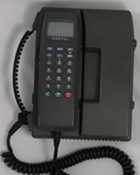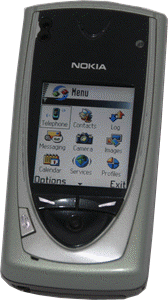The first mobile phone to...
What was the first mobile phone? What was the first camera phone, or the first phone with a colour screen? What was the first 3G handset? What was the first phone on the GSM network?
The mobile phone industry has developed enormously since the world's first hand portable phone in 1983. This is the story told through the evolution of mobile handsets.
1946 - first mobile phone call
The first genuine mobile phone call took place in Missouri in 1946 when A T & T launched the world's first carphone service. It was only available within a small area and to a very limited number of customers. The cellular technology that would make mass mobile communication possible had not been invented.

1983 - first hand portable mobile phone
The Motorola 8000X was first mobile phone that was not bound to a car or to a huge battery pack. Back in 1973, Dr Martin Cooper made the first ever cell phone call on a prototype of this phone.
Back in the day, ownership of one of these handsets was a huge status symbol. People stopped to stare at such an unusual sight as someone making phone call in the street, in a restaurant, or on a train.
Today the Motorola 8000X has a place in history, as well as being a desirable collectors' piece.

1991 - first GSM phone and first phone to receive a text
GSM started in Europe in 1991 and there was a race to have the first mobile handset registered for the new digital system. In a familiar story, a British company rose to the challenge, but failed to capitalise on the advantage.
The first GSM phone was the Orbitel TPU 900. It was a down market transportable style phone, the type preferred by the building trade, rather than a glamorous hand portable. Motorola, Nokia and Ericsson all brought out their own handsets a few months later and Orbitel was quietly forgotten.
Although, Orbitel had one more first. On 3 December 1992, Neil Papworth, sent the world's first text "Merry Christmas" to Vodafone director Richard Jarvis, who received it on an Orbitel TPU 901.

1992 - first UK consumer phone
Consumers rather than business users were slow to take to mobile phones. In 1990, they still perceived mobiles as too expensive.
Motorola designers thought simplicity and an emphasis on emergency use only was a way to win over consumers. The Motorola Personal Phone, based on the style of a contemporary cordless phone, had no screen and very few functions. The Personal Phone worked on the old analogue system though. In the end digital would be the key to the consumer market.

1993 - first One2One phones
Before GSM officially launched, the UK Government offered two new licences for mobile service providers on a new digital frequency of 1800MHz called PCN. The two new providers were Orange and One2One. Both slanted their offering towards consumers rather than business users. The first to announce a new service was Mercury One2One.
Mercury offered two new phones, the M200, made by Siemens and the M300 made by Motorola. Both sported Mercury logo and a unique colour scheme.
1994 - first phone with the Nokia tune
The Nokia 2110 was Nokia's second GSM phone. At the time it was the most desirable business handset in Europe. The groundbreaking design by Frank Nuovo gave people one of the smallest and lightest GSM phones, as well as a new menu system which was easy to use. The menu system offered a choice of ringtones, one of which was the Grande Valse, now known as the ubiquitous Nokia tune.

1994 - first Orange phone
Mercury's phones were a little on the cheap and cheerful side. Orange gave customers the chance to own one of the top mobiles of the time, the Orange branded Nokia 2140, a variation of the Nokia 2110. The mobile phone press called it the Nokia Orange.
1997 - first phone without an external aerial
The first mobile phone without an external aerial to go on sale in Europe was the German made Hagenuk GlobalHandy.

1997 - first customisable phone
Pressure from aftermarket accessory manufacturers led mainstream handset makers to offer customisation. The Ericsson GA628 was the first phone you could officially customise to your own taste. It was aimed at a younger market than traditional mobile phone buyers and started a trend. However, only the panel around the keyboard was interchangeable.
1997 - first GSM PAYG phone
The Nortel m900 was the UK's first GSM phone available on a PAYG deal. Mercury realised the potential of selling phones without a contract and launched the first GSM PAYG phones in October 1997.
1997 - first phone with a colour screen
The Siemens S10 was technically the first phone to offer a colour screen. However, it only had four colours and only the text was in colour. It did not catch on.

1998 - first phone with interchangeable fascias
Ericsson might have shown the way, but Nokia did it better. The Nokia 5110 was the first phone with interchangeable fascias or XpressOn covers as Nokia called them. It was an instant success and started a trend that meant nearly all mobiles had to be customisable.

1999 - first WAP phone
In February 1999 Nokia announced the world's first phone with a WAP (Wireless Application Protocol) browser, the Nokia 7110. It was the first phone capable of browsing the internet. Not only that, it had the ultra cool Matrix inspired sliding case, making it instantly the most desirable handset.
However, WAP was a limited sanitised version of the internet which did not please users.

1999 - first tri-band GSM phone
Travelling to Europe, the Middle-East, Asia, Africa and the USA? Don't worry about your mobile, the Motorola Timeport, the world's first tri-band GSM phone, worked around the globe. It was the prefect phone for the high flying exec.

2000 - first camera phone
The Sharp J-SH04, launched in November 2000, was the world's first commercially available camera phone. The only snag: you could only use it in Japan.
2001 - first phone with a full colour display
The Mitsubishi Trium Eclipse was the first phone to offer a full colour display in the UK. It just pipped the much more exciting Ericsson T68i.
2002 - UK's first picture messaging service
T-Mobile announced the UK's first picture messaging service in 2002, using the Sony Ericsson T68i. It was not a camera phone; you needed to attach a separate camera module.

2002 - Europe's first camera phone

The Nokia 7650 was something really special. It was Europe's first phone with a Symbian operating system and Europe's first phone with a built-in camera. Expensive at the time at £200 and only available on contract, it was a huge success with young mobile users eager to adopt the latest trend from Japan.
2003 - UK's first 3G handsets
3G brought in a huge amount of revenue to the UK Treasury, however, network providers were slow to put it in place. The first UK's 3G offering was a new network '3' which launched on 3/3/2003.
'3' offered a choice of three handsets: the Motorola A830, the NEC e606 and NEC e808.